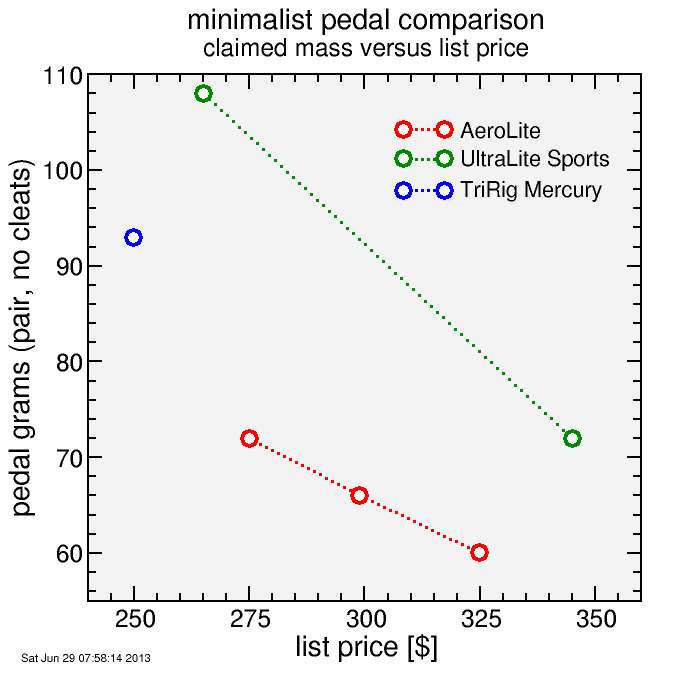minimalist pedals: weight vs price
There's now three minimalist pedal systems on the market, as I pointed out in a previous post:
- Aerolite: the original, from 1979, very early days for clipless pedals. Cleats are set up for 4-hole mounting, like Speedplay but with a different spacing, although they can also be mounted in 2-hole (mountain bike) shoes or 3-hole (using 2 of the 3 holes).
- Ultralite Sports: I became introduced to these at Interbike last year: very slick. They have a novel clip-in, clip-out mechanism.
- TriRig Mercury: still in limited release, closer to the Aerolite than the Ultralite Sports, but with 3-hole cleats rather than 4-holes.
Aerolite makes 3 models of pedal. The lightest is "time trial" version with holes drilled in the Turcite sleeve which surrounds the axle, and also the spindles have minimal length to keep the feed close to the bike, which was considered more aerodynamic back then. Then they have a "criterium" pedal, also with short spindles, in this case not for aerodynamics but to improve cornering clearance. Then finally they have a "road" version with a longer spindle. All are made of hollow titanium: I think there was at one point a steel version but that's no longer available. These pedals have had a truly amazing run.
The clip-in is amazingly simple: the nylon cleat contains a semicircular hole whose surface extends a bit more than 180 degrees. So the rider simply puts his foot in the correct position then applies pressure. That causes the nylon to sufficiently spread that it snaps over the pedal sleeve.
There's a discussion here on the WeightWeenies forum. Like most things which trade functionality for lightness, people seem attracted to them but then subsequently move on.
Ultralite Sports is a bit different, with a different clip-in mechanism. They have two versions: a more expensive Ti version and a heavier steel version. There's a good review on BikeRadar here. What I love about the review is they point out a critical deficiency: the pedals can't be used with street shoes. That's a big deal for me. Even for race-only pedals, sometimes you want to hop on your bike and go somewhere without changing into cycling shoes. At least with Aerolites and TriRig Mercuries you should be able to pedal in walking shoes. Caley Fretz at VeloNews also did a review of these pedals. There's some nice photos at that review.
One advantage of the Ultralites versus the other shoes is you can get cleats with a small amount (5 degrees) of float. While with proper cleat set-up float shouldn't be necessary, a little float just to shift the load to different muscles temporarily is something I find attractive. A possible specific disadvantage may be clip in and clip out, which is somewhat unique. The inventors claim it just takes a bit of practice. At least the pedal is always in the correct orientation, unlike a one-sided pedal.
TriRig Mercuries were next, and appeared to come rather close to copying the Aerolites. One added benefit they provide is pedal stance ("Q-factor") adjustment, by disassembling then reassembling the pedal in a different configuration. But I don't see this as a big advantage, since Aerolite comes in two different spindle lengths. But adjustability is always good.
I noted in that post that TriRig Mercury had switched from a hollow to a solid Ti spindle to increase strength, but in doing so they added 18 grams to the mass of a pair of pedals. I was interested in how this positioned them relative to the competition. Here's that plot:

If these pedals are your thing, if the TriRig Mercury would go back to the hollow spindle, losing 18 grams, it would be very competitive with the Aerolites and the Ti Ultralite Sports, and at a lower price. Even if the hollow spindle was more expensive, for example as an option, they have some breathing room below the price standard set by the competition.
But an issue with each of these pedals is walking in the shoes. For bike tours, etc, where there's going to be a lot of walking, of course mountain biking pedals are the best option. But some walking happens on every ride I do, and living in crowded San Francisco, I often encounter traffic lights, and at traffic lights I often need to support myself with my foot. Even for race day only pedals, there's going to be a bit of walking. If this is better with one system then another, that's worth something.
So while I find the light weight and mechanical elegance of these pedal systems attractive, I think I'll stick with my tried-and-true Speedplays. Those pedals do everything fairly well as long as they aren't worn out and become sloppy, which they're prone to do.

Comments